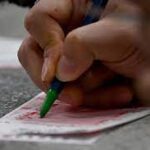Bathurst champ Perkins swaps racetrack for outback and returns with buried treasure

He's raced against the world's best in Formula One, owned his own V8 Supercar team and won Bathurst six times.
But legendary racing driver Larry Perkins says finding the missing cache of an early European explorer is "a whole different page of excitement".
Since retiring from the racing scene in 2012, Perkins has clocked up more than 90,000 kilometres in his heavy-duty four-wheel-drive truck, following old explorer tracks through the Australian deserts.
"They were determined people," Perkins told 7.30.
"They were heading off on journeys with no sure outcome and in many cases it cost them their lives."
It's one of the lesser-known explorers who survived his expedition, but left some unanswered questions, that has intrigued Perkins for the past 18 months.
That explorer was a former Royal Navy captain called Henry Vere Barclay. The Simpson Desert in Central Australia was his destination. The year was 1904.
Barclay left behind a mystery that has baffled historians for decades: What became of the enormous stash of equipment and personal belongings he and his team were forced to abandon in a desperate effort to survive?
They needed to lighten their load by about 400 pounds to cross the sandhills to the next available water source.
Two separate attempts to find the cache — one in 1915, the other five years ago — were unsuccessful.
Perkins wanted to find out why.
He travelled to Adelaide, where a journal of the expedition, written by the team's second in command, Ronald Macpherson, is held at the headquarters of the Royal Geographical Society.
The hand-written diary lists the huge collection of gear the explorers left in the desert and the coordinates of the hiding spot.
"[MacPherson] made a list at the back of the diary and he put the latitude and longitude in there and many people had thought, this will be easy to find," Perkins told 7.30.
"But it didn't stack up.
"I did a lot of homework and found that there's no point in going to the latitude and longitude because the goods can't possibly be there, based on reading all the pages of the journal.
"So I called up my brother and said, 'Do you want to come out and waste a bit of time with me?'"
'We've found it'
After travelling from his home in Melbourne to the middle of the Simpson Desert, Perkins and his brother Peter concentrated on an area about 100 kilometres from the original coordinates in the journal.
After four-and-a-half long days on a quad bike they had towed out to the location, there was finally a breakthrough.
"Peter said, 'What's over there?' Which he had said 100 times before," Perkins said.
"It was only 40 metres away, an unfamiliar shape, so I jumped off the bike and then we could see that it was camel tanks, water tanks that could only have been Barclay's gear.
"And I turned around to Peter and I said, 'We've found it'.
"It was a fantastic feeling that I will never forget."
From there, with the help of a metal detector, they unearthed a substantial cache of equipment, including carpenter's tools, scientific equipment and 600 rounds of ammunition. There were also personal belongings, including painting equipment. Barclay, as it turned out, was a bit of an artist.
With the help of archaeologists provided by the Northern Territory Government, the brothers excavated more of the artefacts, notably some photographic glass plates and a silver membership tag to an unknown club, dating back to 1902.
The cache is described as a "highly significant archaeological find" by Michael Wells, director of the heritage branch of the NT's Department of Tourism and Culture.
Mr Wells took the initial phone call from Perkins, who thought he'd better inform authorities about what he had just uncovered.
"I didn't really understand what we were dealing with at first," Mr Wells said in a statement to 7.30.
"To be honest, I had never heard of Barclay and MacPherson, but I soon realised that this was potentially a very important find.
"The find gives a unique insight into early European exploration of Australia in the late 19th and early 20th centuries."
Historian Dick Kimber was among the last group to search for Barclay's equipment and is a friend of Perkins.
On hearing the news of the discovery of Barclay's cache, the historian paid tribute to Perkins' patience and persistence, calling him "a marvellous example of a modern bushman".
"It's by far the largest intact horde of goods found in an inland context to do with exploration, as far as I know," Mr Kimber said.
"All are valuable from an historical viewpoint."
Still looking
While the relics have now been handed over to the Museum of Central Australia in Alice Springs, Perkins is already planning another trip out to the desert to recover the other half of the cache, which he is convinced must still be lying beneath the sandhills and spinifex.
At his workshop in Melbourne's Sunshine, he's modified his truck for the rigours of the outback, including inventing a special overdrive splitter gearbox that allows it to go faster than 80 kilometres an hour on Australia's highways.
Brought up on a farm in the Victorian Mallee, Perkins has always loved travelling the outback and the "lack of pretence" it offers.
"The people you meet are all individuals," he said.
"No-one is blown up too much. It's just an honest world."
Asked how his recent discovery compares to winning the Bathurst 1000, Perkins said: "I may have won Bathurst but lots of other guys have won Bathurst.
"We found this gear and not too many guys find gear like this.
"We didn't stumble across it. We were looking for it.
"The four-and-a-half days on the quad bike paid off based on enthusiasm, homework and a can-do attitude, which I'm proud of."
[contf]
[contfnew]
ABC .net
[contfnewc]
[contfnewc]
























